9-30-30 sunspot 1110
ROBOTS PLOT TO DESTROY SPITZER SPACE TELESCOPE:
It must be true, because the video comes directly from the Spitzer
Science Center at Caltech.
Tune in here to see how power-hungry robots are plotting to destroy
one of NASA's greatest observatories.
EMPTY ERUPTION:
Yesterday, Sept. 29th around 0830 UT, a translucent filament of
magnetism rose up from the sun's northeastern limb and erupted. NASA's
Solar Dynamics Observatory recorded the action. Click on the image to
launch a five hour time-lapse movie--and keep an eye on the ghostly
loop:
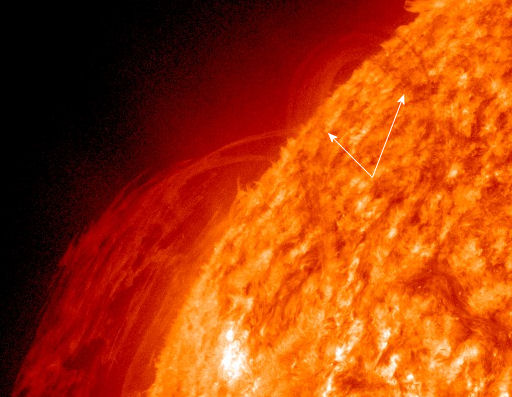
Movie formats:
2 MB gif,
2 MB mpeg,
1.3 MB iPad
This was an "empty eruption." It hurled no
significant cloud of plasma into space. Imagine something exploding with
more power than ten million atomic bombs and not producing a spray of
debris. That's essentially what happened here. The erupting loop was
made of more magnetism than matter.
One end of the loop was rooted near active region
1111, the location of a small but growing sunspot. Readers with solar
telescopes might wish to keep an eye on the area for further
developments.
Solar wind
speed: 380.2 km/sec
density: 0.4 protons/cm3
explanation |
more data
Updated: Today at 2344 UT
X-ray Solar Flares
6-hr max: B2
2320 UT Sep30
24-hr: B6
0555 UT Sep30
explanation
| more data
Updated: Today at: 2340 UT
|
9-29-30 sunspot 1110 -
Sunspot 1110 is crackling with
C-class solar flares. Credit: SDO/HMI. Resolutions:
4096,
1024,
512
Solar wind
speed:
440.0 km/sec
density: 0.3 protons/cm3
explanation |
more data
Updated: Today at 2345 UT
X-ray Solar Flares
6-hr max: B2 1850 UT
Sep29
24-hr: B5
0125 UT Sep29
explanation |
more data
Updated: Today at: 2340 UT
CRACKLING SUNSPOT:
During the past 24 hours, sunspot 1110 has increased in size more than
10-fold. A white-light camera onboard NASA's Solar Dynamics Observatory
took this picture during the early hours of Sept. 29th:
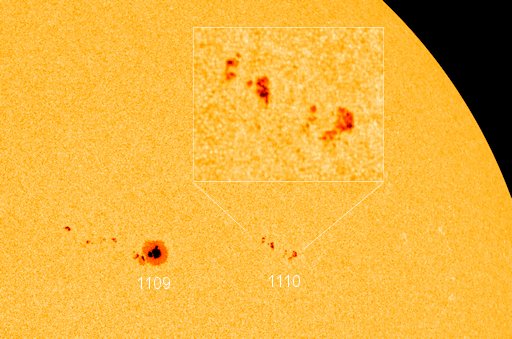
Although it is still small compared to behemoth sunspot 1109 right
behind it, sunspot 1110 is much more active.
Reconnection events in the sunspot's
magnetic canopy have produced at least two C-class solar flares since
yesterday (SDO movies:
#1,
#2). The eruptions were brief and
did not hurl significant clouds of plasma toward Earth. If the sunspot
continues to grow, however, future eruptions could become geoeffective.
|
9-28-10 -sunspot 1109
Solar wind
speed: 529.3 km/sec
density: 0.1 protons/cm3
explanation |
more data
Updated: Today at 2345 UT
X-ray Solar Flares
6-hr max: C1 2210 UT Sep28
24-hr: C1 2210 UT Sep28
explanation |
more data
Updated: Today at: 2340 UT
SOLAR FLARE: This
morning at 0948 UT, tiny sunspot 1110 unleashed a C1-class solar flare (SDO
movie). The sunspot has started to grow
and this event could herald a period of higher activity from the region.
ECLIPSE SEASON FOR SDO:
NASA's Solar Dynamics Observatory (SDO) is
in a geosynchronous orbit around Earth, always hovering directly above a
ground station near Las Cruces, New Mexico, where two large dish
antennas receive SDO's
record-breaking data stream. Most of
the time, this is a great place to be; SDO can see the sun and transmit
data non-stop. But not now. Ralph Seguin of the Lockheed-Martin Solar
and Astrophysics Lab explains: "SDO has entered eclipse season. Around
the time of the equinoxes, the spacecraft, Earth, and sun can line up
almost perfectly. Once a day for about an hour, Earth blocks SDO's view
of the sun." This occasionally produces strange results:
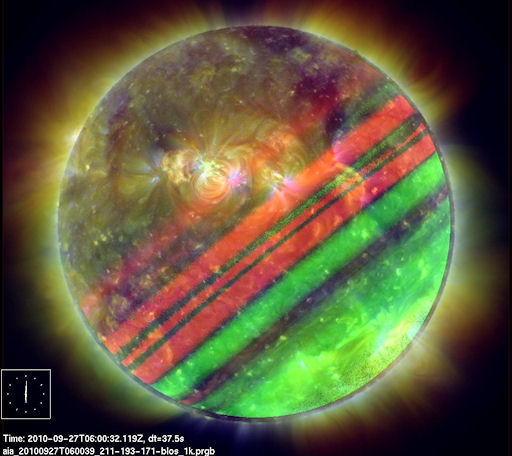
"Now we know," says Seguin, "what it would look like if Jupiter and
the sun had a child."
Seriously, this is a composite of multiwavelength images and a
magnetogram taken by SDO just as the sun was emerging from its daily
blackout. "Magnetograms are computed from a series of images taken over
a short time span. The ribbons of color result from Earth's motion
across the sun during the series of exposures."
Seguin has prepared a movie showing what an eclipse looks like at one
of SDO's extreme ultraviolet wavelengths:
click to play. "Eclipse season will be
over on Oct. 6th," he says. Meanwhile, stay tuned for strange.
SUNSPOT MIRAGE:
Lately, sunspot 1109 has been attracting the
attention of sunset sky watchers. When the sun is dimmed by haze and low
clouds, the behemoth spot can be seen and photographed as a dark mark on
the solar disk. Yesterday evening in San Francisco, the spot got even
bigger when it was stretched and distorted by a lovely
sunset mirage:
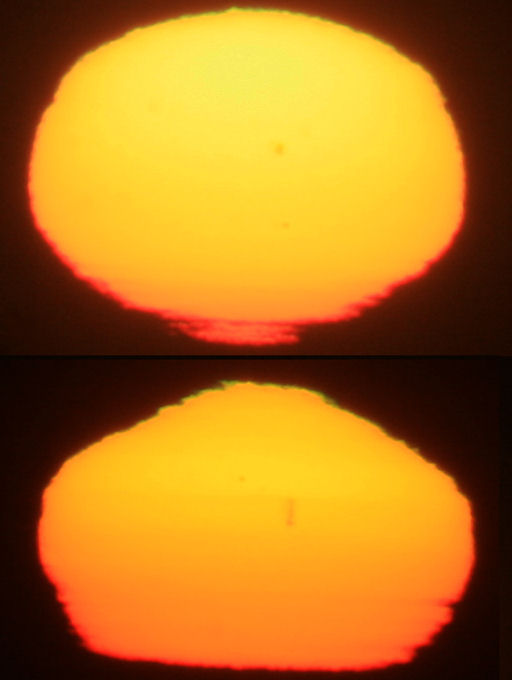
Mila
Zinkova
took the picture overlooking San Francisco Bay. "The sun and sunspot
1109 were constantly changing shape as the sun set," says Zinkova. "It
was wonderful. A small green flash at the end added nicely to the mood."
Click here to view the complete sunset sequence.
Sunspot 1109, which stretches more than 100,000 km from end to end,
is slowly growing as it transits the solar disk. The forecast calls for
another week of sunset sunsets before the region disappears over the
sun's western limb.
more images:
from Aymen Ibrahem of Miami, Alexandria, Egypt;
from Konstantinos Christodoulopoulos of Agioi Theodoroi beach,
Korinthia, Greece
|
9-27-10 sunspots 1108 and 1109 are quiet
Solar wind
speed: 467.0 km/sec
density: 1.4 protons/cm3
explanation |
more data
Updated: Today at 0215 UT
X-ray Solar Flares
6-hr max: B3
2130 UT Sep26
24-hr: B7
1250 UT Sep26
explanation
| more data
Updated: Today at: 2355 UT
|
9-26-10 sunsots 1108 and 1109 are quiet
Solar wind
speed: 471.8 km/sec
density: 2.1 protons/cm3
explanation |
more data
Updated: Today at 2344 UT
X-ray Solar Flares
6-hr max: B3
2130 UT Sep26
24-hr: B7
1250 UT Sep26
explanation
| more data
Updated: Today at: 2340 UT
TRIPLE RAINBOW: Double rainbows are commonplace.
Sunlight
reflected once inside raindrops produces the primary arc; sunlight
reflected
twice produces the secondary. Most people who have seen a single
rainbow, have also seen a double.
But have you ever seen a triple? Daryl Pederson of
Anchorage, Alaska, spotted one on Sept. 20th:
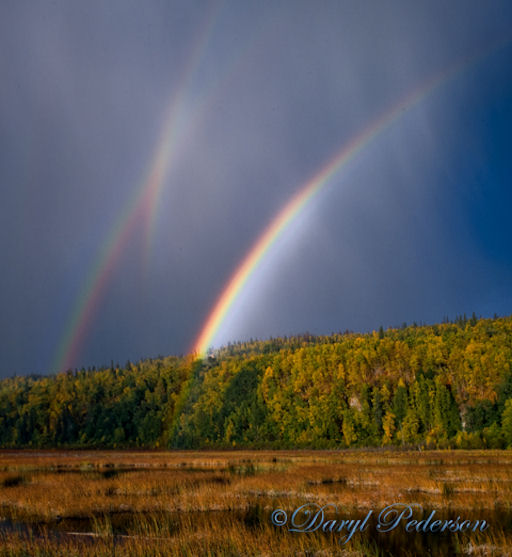
Here's something you don't see every day--three rainbows at once!"
says Pederson. "The bonus third rainbow was caused by an image of the
sun reflected from Potter's Marsh into the falling rain above."
Three rainbows is not the record, however. Atmospheric optics expert
Les Cowley has documented cases of
four,
five and even
six bows in the same scene. Read all about
them
here.
more images:
from Calvin Hall of Beluga Point near
Anchorage Alaska;
from John Maynard of Mt. Rushmore, South
Dakota;
from Jeff Berkes of Kilo, Hawaii;
from Marko Korosec of Dolenja vas, Senozece,
Slovenia, Europe;
from Alan Dyer of Cluny, Alberta, Canada;
from Slanec Erich of Vienna, Austria
|
9-25-10 sunspot 1108 is
slowly decaying
Solar wind
speed: 462.2 km/sec
density: 2.2 protons/cm3
explanation |
more data
Updated: Today at 2345 UT
X-ray Solar Flares
6-hr max: B1
1810 UT Sep25
24-hr: B4
0220 UT Sep25
explanation
| more data
Updated: Today at: 2340 UT
|
9-24-10 sunspot 1109 is growing again
Solar wind
speed: 572.5 km/sec
density: 1.6 protons/cm3
explanation |
more data
Updated: Today at 2347 UT
X-ray Solar Flares
6-hr max: B1
1855 UT Sep24
24-hr: B2
0125 UT Sep24
explanation
| more data
Updated: Today at: 2340 UT
|
9-23-10 sunspot 1109 poses a threat
Solar wind
speed: 465.0 km/sec
density: 0.5 protons/cm3
explanation |
more data
Updated: Today at 2345 UT
X-ray Solar Flares
6-hr max: B2
1915 UT Sep23
24-hr: B2
0050 UT Sep23
explanation
| more data
Updated: Today at: 2340 UT
AUTUMN SUNRISE:
Today in Veszprem, Hungary, photographer Monika Landy-Gyebnar woke up
early and went outside at dawn to photograph the
first sunrise of autumn. "The distant valley
fog was painted pink and orange by the colors of the rising sun," she
says. "Later, when I was looking closely at the pictures, I also found a
couple of sunspots."
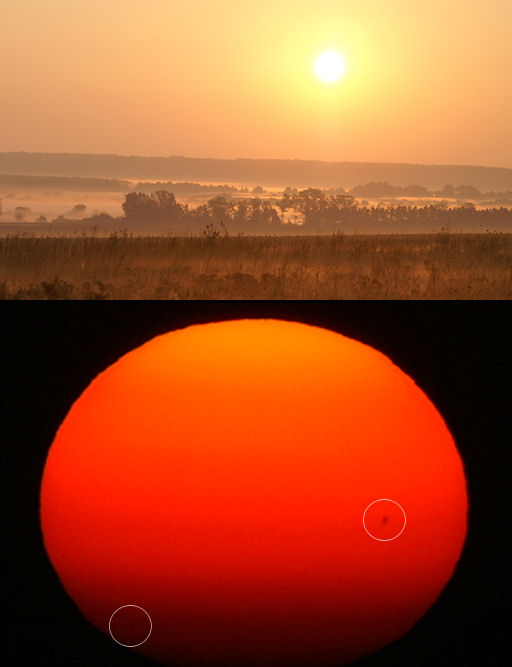
Sunspots 1108 and 1109 have grown so large, they can now be seen
without the amplification of a solar telescope. NOAA forecasters
estimate a 10% chance of an M-flare from one of these behemoths in the
next 24 hours, and that could lead to fall colors of a different kind-- Northern
Lights. "Autumn is my favourite season and it
seems to be getting off to a good start!" says Landy-Gyebnar.
AUTUMN MOONRISE:
Last night's full moon was the "Harvest Moon," the
first full moon of northern autumn. It arrived on the very night of the
autumnal equinox, rising at sunset to chase the summer sun away:
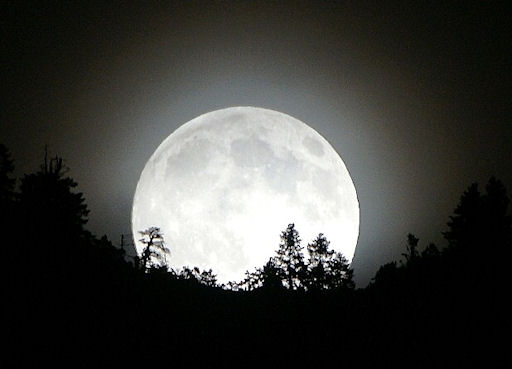
"The sight of this
Super Harvest Moon beaming through the trees,
inflated to gargantuan proportions by the Moon illusion, made me feel
like howling," says photographer Vasilis Wooseas of Greece. Onlookers
elsewhere felt the same way. Browse the links below for examples.
more images:
from Doug Zubenel of De Soto, Kansas;
from Jan Lameer at Amsterdam harbour, the
Netherlands;
from Dave Lengyel of Brighton township, Ohio;
from Monika Landy-Gyebnar of Veszprem,
Hungary;
from Malcolm Park of Columbus, Ontario;
from Bob Collins of Ormond Beach, FL;
from Dusty Hicks of Nowata , Oklahoma;
from Adrian New of San Antonio, Texas;
from Robert Schalck of North Bend, Oregon
|
9-22-10 sunspot 1108 - 1109
Emerging sunspot 1109 poses a greater
than 40% chance of
C-class solar flares during the next 24 hours. Credit: SDO/HMI.
Resolutions:
4096,
1024,
512
It took 23 seconds to cross the sky and was nearly as
bright as the full Moon," says Thomas Ashcraft, who operates the camera.
"The fireball made a sonic boom loud enough to be heard inside above fan
noise and household din. At first I thought it was thunder."
After passing over New Mexico, the fireball apparently
continued on to Texas. "At 10:05 pm CDT (9:05 pm MDT) on Sept. 21st we
witnessed a slow-moving fireball entering from the west and headed ENE,"
reports Matthew Byrd of Amarillo. "It was very bright white and shedding
white sparks." Remarkably, the first fireball was followed by a second.
"Nearly 7 or 8 min later another was sighted directly over Amarillo
moving the same direction," adds Byrd.
US Space Command reports no satellites or pieces of
space junk decaying at the time of the sightings. This was probably a
random meteoroid--and maybe two--disintegrating in Earth's atmosphere.
SOUTHWESTERN FIREBALL: Last night (Sept. 21st)
around 09:01 pm MDT, a dazzling fireball glided across the skies of New
Mexico and west Texas. "We’ve been getting a lot of calls in the
newsroom about an object – maybe a meteorite – falling from the sky,"
says Peter St. Cyr of KOAT TV in Albuquerque. An all-sky camera outside
Santa Fe caught the object in flight. Click on the image to launch a 5
MB movie: Note: In
the movie, the stationary light is the full Moon, the moving light
is the fireball.
Solar wind
speed: 310.3 km/sec
density: 0.4 protons/cm3
explanation |
more data
Updated: Today at 1145 UT
X-ray Solar
Flares
6-hr max: B8
0505 UT Sep22
24-hr: B8 0505 UT Sep22
explanation
| more data
Updated: Today at: 1140 UT
|
9-21-10 sunspot 1108
FAILURE TO LAUNCH:
Sept. 21st began with a eruption on the sun's
northeastern limb that ... couldn't ... quite ... lift off. NASA's Solar
Dynamics Observatory recorded the action:
The one-hour blast produced neither a
bright flash of electromagnetic radiation (a "solar flare") nor a
substantial coronal mass ejection (CME). It just bounced up and down
above the stellar surface. More potent events may be just around the
corner. A magnetic active region crackling with B- and C-class solar
flares is about to emerge over the northeastern limb. Indeed, this event
probably came from its leading edge. Stay tuned for solar activity.
Solar wind
speed: 393.6 km/sec
density: 0.5 protons/cm3
explanation |
more data
Updated: Today at 2345 UT
X-ray Solar Flares
6-hr max: B4
1800 UT Sep21
24-hr: C1
0755 UT Sep21
explanation
| more data
Updated: Today at: 2340 UT
|
9-20-10 - sybsoit 1108
JUPITER AT ITS BEST: Tonight, Sept. 20-21, Earth
and Jupiter converge for their closest encounter in decades. The giant
planet will soar across the sky at midnight, outshining everything
except the Moon itself. Although big, bright Jupiter will remain close
to Earth for weeks to come, tonight is the closest of all.
If Jupiter is up at midnight, it must be opposite the sun:
diagram. Indeed, astronomers call this "Jupiter's night of
opposition." The effect of opposition may be seen in the shadow of
Jupiter's moon Io, shown here in a photo taken last night by Anthony
Wesley of Australia:
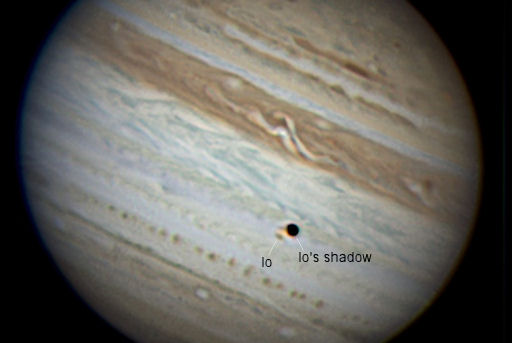
"Io was almost on top of its own shadow," points out
Wesley. "This is due to the near-perfect alignment of Jupiter, Earth and
the sun."
In a coincidence of interplanetary proportions, Uranus
is also at opposition tonight. This rare double opposition of two giant
planets is a once-in-a-lifetime event. Unlike Jupiter, Uranus is barely
visible to the naked eye, a result of its smaller size and greater
distance. It looks great, however, through a small telescope. Just point
your optics at Jupiter and you will
find
emerald Uranus about 1o away.
more images:
from Alan Friedman at the Mt. Wilson Observatory in California;
from Pete Lawrence of Selsey, West Sussex, UK;
from Efrain Morales Rivera of Aguadilla, Puerto Rico;
from Sadegh Ghomizadeh of Iran Tehran;
from Jerôme Grenier of Paris, France;
from Frank Olsen of Tromvik, Norway;
from Jimmy Eubanks of Boiling Springs, SC;
from Mark Humpage of Lutterworth, UK;
from P. Nikolakakos of Sparta, Greece;
Solar wind
speed: 317.1 km/sec
density: 2.0 protons/cm3
explanation |
more data
Updated: Today at 1654 UT
X-ray Solar Flares
6-hr max: B2 1135 UT Sep20
24-hr: B2 1135 UT Sep20
explanation
| more data
Updated: Today at: 1655 UT
|
9-19-10 sunspot 1108
|
Solar wind
speed: 330.6 km/sec
density: 0.3 protons/cm3
explanation |
more data
Updated: Today at 1754 UT
X-ray Solar Flares
6-hr max: B1
1345 UT Sep19
24-hr: B2
0730 UT Sep19
explanation |
more
data
Updated: Today at: 1755 UT
|
|
9-18-10 1106/1100 and 1108
BIG SUNSPOT: One of the biggest sunspots of new
Solar Cycle 24 is rotating around the sun's southeastern limb.
Presenting ... active region 1108:
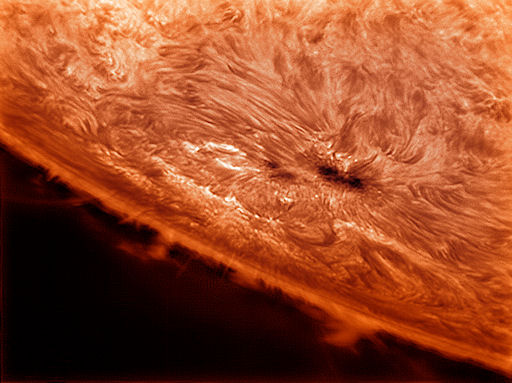
Rogerio Marcon took the picture yesterday from his
backyard observatory in Campinas, Brasil. Although the sunspot is
big---the primary core is twice as wide as Earth--it has not yet
produced any significant eruptions, only a smattering of B-flares and
one C-class event. The quiet may be temporary. The sunspot's
magnetic field harbors energy for major activity. NOAA forecasters
estimate a 25% chance of an
M-flare during the next 24 hours.
more images:
from John Stetson of Portland, Maine;
from Peter Paice of Belfast, Northern Ireland;
from John Nassr of Baguio, Philippines;
from Jo Dahlmans of Ulestraten the Netherlands;
from Cai-Uso Wohler of Bispingen, Germany;
from Robert Arnold of Isle of Skye, Scotland;
from Peter Desypris of Syros Greece;
from James Kevin Ty of Manila , Philippines
Solar wind
speed: 398.4 km/sec
density: 0.1 protons/cm3
explanation |
more data
Updated: Today at 2344 UT
X-ray Solar Flares
6-hr max: B1
2220 UT Sep18
24-hr: B4
0850 UT Sep18
explanation
| more data
Updated: Today at: 2340 UT
|
9-17-10 sunspots 1106/1100 and new
1108
Sunspot 1108 is
crackling with B- and
C-class solar
flares. Credit: SDO/HMI.
Resolutions:
4096,
1024,
512
Solar wind
speed: 456.1 km/sec
density: 1.8 protons/cm3
explanation |
more data
Updated: Today at 2347 UT
X-ray Solar Flares
6-hr max: B2
2155 UT Sep17
24-hr: B9
0120 UT Sep17
explanation
| more data
Updated: Today at: 2340 UT
i |
9-16-19 sunspot 1106/1100
Solar wind
speed: 477.0 km/sec
density: 3.0 protons/cm3
explanation |
more data
Updated: Today at 2345 UT
X-ray Solar Flares
6-hr max: B4
2235 UT Sep16
24-hr: B5
0225 UT Sep16
explanation
| more data
Updated: Today at: 2340 UT
|
9-15-10 sunspot 1106/1100
EMERGING SUNSPOT: A new sunspot is emerging over
the sun's southeastern limb, and its magnetic canopy is seething with
activity. Click on the image to watch 90 minutes of action recorded
during the late hours of Sept. 15th by NASA's Solar Dynamics
Observatory:
Because the sunspot's dark core is visible
only in profile, its characteristics are a matter of guesswork. NOAA
forecasters say that "C-class events are likely." If so, the eruptions
will blow into space over the sun's limb--a nice photo-op for readers
with solar telescopes. Stay tuned for updates and better views as the
sunspot turns toward Earth.
Solar wind
speed: 363.9 km/sec
density: 0.9 protons/cm3
explanation |
more data
Updated: Today at 2345 UT
X-ray Solar Flares
6-hr max: B4
2225 UT Sep15
24-hr: B7
1715 UT Sep15
explanation
| more data
Updated: Today at: 2340 UT
|
6-14-10 sunspot 1106/1100
Solar wind
speed: 374.1 km/sec
density: 1.5 protons/cm3
explanation |
more data
Updated: Today at 2345 UT
AURORA WATCH: There's a reason they call Alaska
"aurora country." Last night near Fairbanks, for no particular reason,
the sky turned green:
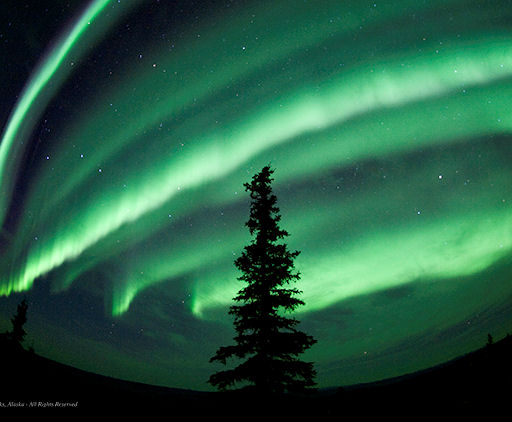
"It was a nice quiet display that lasted more than an
hour," reports photographer Lance Parrish of Skiland. "I had plenty of
time to record the show using my
Nikon D3. A 10 second exposure at 1600 ISO
worked very nicely."
Alaskans and other Northerners should take note of those
settings, because tonight there is a reason for auroras. The sun's
magnetic field is tipping south, opening
a crack in Earth's magnetosphere. Solar wind
pouring in could fuel a renewed display.
Sept. 2010 Northern Lights Gallery
[previous Septembers:
2009,
2008,
2007,
2006,
2005,
2004,
2002,
2001,
2000]
X-ray Solar Flares
6-hr max: B1
2130 UT Sep14
24-hr: B1
2130 UT Sep14
explanation
| more data
Updated: Today at: 2340 UT
|
9-13-10 sunspot 1106 is actually 1100
coming around again
Solar wind
speed: 290.1 km/sec
density: 0.4 protons/cm3
explanation |
more data
Updated: Today at 2345 UT
X-ray Solar Flares
6-hr max: B1
2130 UT Sep13
24-hr: B2
0435 UT Sep13
explanation
| more data
Updated: Today at: 2340 UT
Planet Smells Funny
Sept. 13, 2010: Giant planet GJ 436b in the
constellation Leo is missing something.
Would you believe swamp gas?
To the surprise of astronomers who have been studying the
Neptune-sized planet using NASA's Spitzer Space Telescope, GJ 436b has
very little methane (CH4).
"Methane should be abundant on a planet of this temperature and size,
but we found 7000 times less methane than what the models predict," says
Kevin Stevenson of the University of Central Florida (UCF). Stevenson
was lead author of a paper reporting the result in the April 22, 2010,
issue of Nature.
The methane deficit is surprising because in our own solar system all
gas giants are methane-rich. Hydrogen and carbon are abundant in the
atmospheres of Jupiter, Saturn, Uranus and Neptune. These atoms
naturally get together to form the simplest hydrocarbon, CH4.
The example of our local gas giants shaped expectations when
Stevenson and colleagues pointed Spitzer in the direction of GJ 436b,
only 33 light-years away. Finding methane was a foregone conclusion. But
when the researchers analyzed the planet's spectrum, they found little
of it. Instead, the atmosphere was rich in carbon monoxide.
"Actually, it blew our minds," says principal investigator and
co-author Joseph Harrington, also of UCF.
Where did all the methane go? One possibility: it's being broken
apart. "UV radiation from the planet's star could be converting the
methane into polymers like ethylene," says Harrington. "If you put
plastic wrap out in the sun, the UV radiation breaks down the carbon
bonds in the plastic, causing it to deteriorate as the long carbon
chains break. We propose a similar process on GJ 436b, but there
hydrogen atoms split off from methane and let the remnants stick
together to make ethylene (C2H4)."
Also, they speculate, strong vertical winds in the planet's
atmosphere might be sweeping up material from deep hot layers where
carbon monoxide is abundant. CO thus replaces CH4.
Or it could be something else entirely.
"This planet's atmosphere could have some sort of alien chemistry
going on," says Harrington. "We just don't know yet."
Giant planets aren't the only worlds with methane. CH4 is
fairly common on Earth, too. Methane forms in the stomachs of cows and
goats. It also bubbles up from the bottom of swamps, a byproduct of
organic matter decaying in deep mud. On gas giants, methane is just
common chemistry, but on our planet, it is a sign of life.
For this reason, researchers have long planned to look for methane in
the atmospheres of distant Earth-sized planets. NASA's Kepler mission is
expected to discover many Earth-sized planets over the next few years,
so the scientists will have plenty of promising targets to pursue.
Methane floating alongside oxygen could be compelling evidence of
biological activity.
But what if planetary atmospheres don't always follow the rules of
our own Solar System? GJ 436b certainty doesn't. Investigators might
have to go back to the drawing board and re-figure their chemistry.
"GJ 436b is telling us something important," says Harrington: "We’re
not in Kansas anymore."
Authors:
Dr. Tony Phillips,
Dauna Coulter | Credit: Science@NASA
|
More Information |
|
Other authors of the Nature paper reporting this result
include: Sarah Nymeyer, William C. Bowman, Ryan A. Hardy and
Nate B. Lust from the University of Central Florida; Nikku
Madhusudhan and Sara Seager of the Massachusetts Institute
of Technology, Cambridge; Drake Deming of NASA's Goddard
Space Flight Center, Greenbelt, Md.; and Emily Rauscher of
Columbia University, New York.
JPL manages the
Spitzer Space Telescope mission for NASA's Science
Mission Directorate, Washington. Science operations are
conducted at the Spitzer Science Center at Caltech. Caltech
manages JPL for NASA. |
|
9-12-10 - 1100, 1006
Solar wind
speed: 324.0 km/sec
density: 0.4 protons/cm3
explanation |
more data
Updated: Today at 1004 UT
X-ray Solar Flares
6-hr max: B1 0805 UT
Sep12
24-hr: B1
0805 UT Sep12
explanation
| more data
Updated: Today at: 1000 UT
|
9-11-10 mo new subspos but 1100 is
returning
NEW ERUPTION--UPDATE: During the waning hours of
Sept. 10th, a magnetic filament erupted in the sun's northern
hemisphere:
SDO movie. Newly-arriving data from the Solar and Heliospheric
Observatory clearly show a CME emerging from the blast site:
SOHO movie. Although the CME is not heading toward Earth, the
outskirts of the expanding cloud could hit our planet's magnetic field
during the late hours of Sept 12th or Sept. 13th. High-latitude sky
watchers should be alert for auroras.
Solar wind
speed: 350.9 km/sec
density: 1.0 protons/cm3
explanation |
more data
Updated: Today at 2345 UT
X-ray Solar Flares
6-hr max: B3
1805 UT Sep11
24-hr: B4
0810 UT Sep11
explanation
| more data
Updated: Today at: 2340 UT
|
1-10-10 no sunspots
Solar wind
speed: 405.3 km/sec
density: 0.7 protons/cm3
explanation |
more data
Updated: Today at 2345 UT
X-ray Solar Flares
6-hr max: B5
2325 UT Sep10
24-hr: B5
2325 UT Sep10
explanation
| more data
Updated: Today at: 2340 UT
TRICKY CLOUD SHADOWS: Which is higher, the
contrail or the fluffy clouds? Inspect the shadows, then scroll down for
the answer:
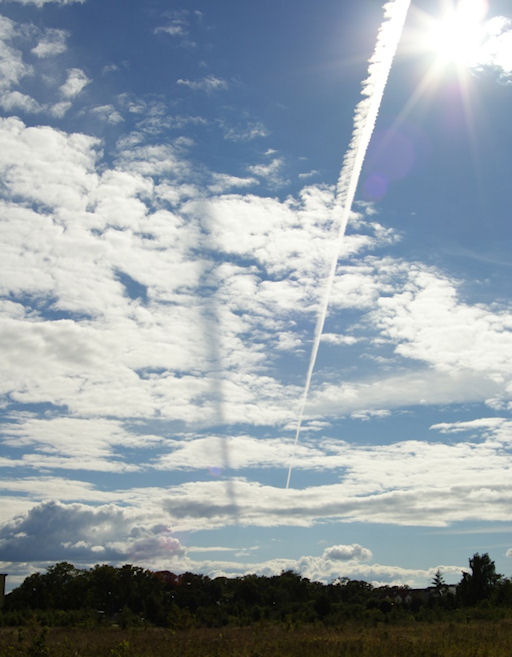
Contrary to appearances, the contrail is higher. It must
be, because its shadow falls down on the clouds below.
Joanna Fengler took the picture yesterday from Rewal,
Poland. "I was walking at the seaside with my family when we noticed
this nice shadow cutting acoss the sky. It was a nice holiday
atmospheric observation and an opportunity to explain the phenomenon to
my small daughter."
Contrail shadows can be very tricky. They often appear
to be on the wrong side of the contrail, disobeying the basic rules of
ray propagation. Atmospheric optics expert Les Cowley explains the
phenomenon
here. When you see a contrail in the sunlit
sky, look for the shadow. Where you
find
it might surprise you.
|
9-9-10 no sunspots
EARTH DODGES ANOTHER BULLET: Just as sunspot
1105 was turning away from Earth on Sept. 8th, the active region
erupted, producing a C3-class solar flare (peak @ 2330 UT) and a
fantastic prominence. Here is a snapshot from the Solar Dynamics
Observatory:
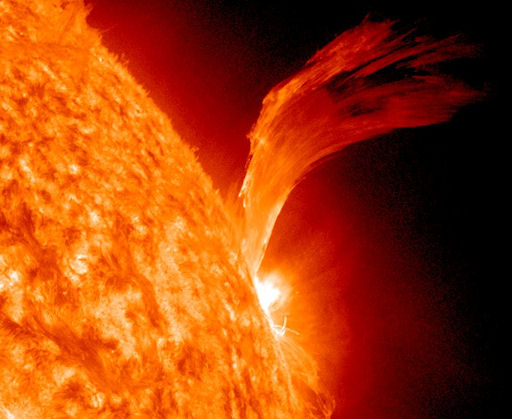
The eruption also hurled a bright coronal mass ejection (CME) into
space:
SOHO movie. The expanding cloud is heading into a part of the solar
system not currently occupied by any planet--it's going to miss
everything, including Earth. If such a CME did hit Earth's magnetic
field, it would probably trigger strong geomagnetic storms. Maybe next
time
Solar wind
speed: 460.9 km/sec
density: 2.2 protons/cm3
explanation |
more data
Updated: Today at 2345 UT
X-ray Solar Flares
6-hr max: B1
2255 UT Sep09
24-hr: C2
0000 UT Sep09
explanation
| more data
Updated: Today at: 2340 UT
|
9-8-10 sunspot 1005
Solar wind
speed: 352.2 km/sec
density: 3.2 protons/cm3
explanation |
more data
Updated: Today at 2345 UT
X-ray Solar Flares
6-hr max: C3
2330 UT Sep08
24-hr: C3
2330 UT Sep08
explanation
| more data
Updated: Today at: 2340 UT
GROUND CURRENTS IN NORWAY:
Rob Stammes operates a
geomagnetic observatory in Lofoten, Norway, and he is measuring
strong ground currents on Sept. 8th: "Magnetic
activity began around 15.00 UT," says Stammes. "The ground currents are
much stronger than last night when the auroras were bright. If this
continues, we might see an even better display this evening."
PURPLE AURORAS: Auroras are
dancing around the Arctic Circle today and some of them are purple. Here
is how the sky looked this morning, Sept. 8th, over Bø, Norway:
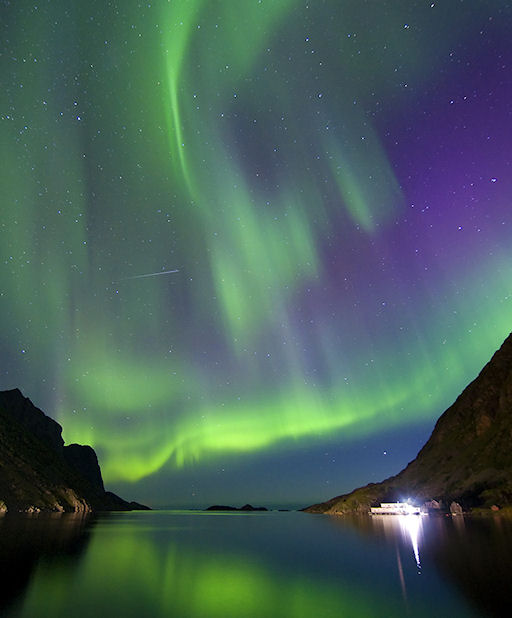
It's not often I get to see purple
auroras," says photographer Øystein Lunde Ingvaldsen. "This was truly a
fantastic sight!"
Auroras get
their colors from specific atoms and
molecules in Earth's atmosphere. Green comes from oxygen molecules
excited by geomagnetic activity. Purple, on the other hand, is usually a
mixture of red and blue emissions from molecular nitrogen. O2
and N2
were both revved up in Norway last night!
More purple is possible tonight as
a solar wind stream continues to buffet Earth's magnetic field.
High-latitude sky watchers should remain
alert for
auroras.
|
9-7-10 sunspot - 1006
Departing sunspot 1105 is crackling
with
B- and C-class solar flares. Credit: SDO/HMI
Resolutions:
4096,
1024,
512
Solar wind
speed: 438.6 km/sec
density: 8.3 protons/cm3
explanation |
more data
Updated: Today at 2345 UT
X-ray Solar Flares
6-hr max: B1 1745 UT Sep07
24-hr: B6 0620 UT Sep07
explanation |
more data
Updated: Today at: 2340 UT
DOUBLE ASTEROID FLYBY:
It's a cosmic coincidence. Two
asteroids, each about 10 to 15 meters wide, will fly past Earth within
hours of one another on Sept. 8th. Although both are coming inside the
orbit of the Moon, there is no danger of impact. At closest approach,
2010 RF12 will be 77,000 km (0.2 LD)
away;
2010 RX30 will be even farther at 231,000 km
(0.6 LD). Advanced amateur astronomers may be able to track the
asteroids using
these
ephemerides. The fast-moving space rocks will
shine like stars of 15th or 16th magnitude. Good luck, observers!
|
9-6-10 sunspot 1105 is cracking wildly
RASH SUNSPOT:
It looks like the sun has
developed rash. Sunspot group 1105 consists of more than 25 tiny spots
scattered across an area some 40,000 km wide. Sascha Somodji sends this
picture of the busy active region from his backyard observatory in
Krefeld, Germany:
Sunspot group 1105 stands in marked contrast to nearby sunspot 1101,
which consists of a single dark core. (Click
here to see the two side by side.) If sunspot 1101 looks boring,
that's because it is. The sunspot's magnetic underpinnings resemble a
simple dipole, and the spot is correspondingly quiet. Sunspot group
1105, on the other hand, is much more complicated with a profusion of
opposite magnetic polarities popping up and bumping together.
Magnetic reconnection is happening there almost non-stop, causing
sunspot 1105 to crackle with B-class solar flares. It is, indeed, a
"rash sunspot."
more images:
from Rolf Girssmann of Boostedt, Germany;
from Cai-Uso Wohler of Bispingen, Germany
Solar wind
speed: 382.7 km/sec
density: 1.9 protons/cm3
explanation |
more data
Updated: Today at 1403 UT
X-ray Solar Flares
6-hr max: B4 0920 UT Sep06
24-hr: B4 0920 UT Sep06
explanation
|
more data
Updated: Today at: 1400 UT
|
9-5-10 subspot 1105
LIMB EXPLOSION: On Sept. 4th around 1600 UT, a
magnetic filament erupted and hurled a massive coronal mass ejection
(CME) off the sun's northwestern limb. Click on the image to view a
close-up movie of the blast from NASA's Solar Dynamics Observatory:
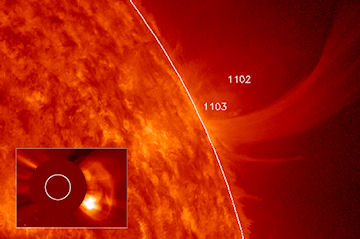
Another movie from the Solar and Heliospheric Observatory (SOHO)
shows the CME billowing into space. The cloud is not heading toward
Earth, and no geomagnetic storms are expected from this blast.
However, space weather could be in the offing for a
different reason. A solar wind stream is heading for Earth and it could
spark auroras when it arrives on Sept. 5th or 6th. NOAA forecasters
estimate a 50% chance of geomagnetic activity at high latitudes. People
in Alaska, Canada, Scandinavia and Antarctica should be alert for
auroras in the nights ahead.
Current conditions
Solar wind
speed: 391.5 km/sec
density: 0.1 protons/cm3
explanation |
more data
Updated: Today at 2344 UT
X-ray Solar Flares
6-hr max: B2
2145 UT Sep05
24-hr: B5
1455 UT Sep05
explanation
| more data
Updated: Today at: 2340 UT
|
9-4-10 subspot 1105
Current conditions
Solar wind
speed: 344.2 km/sec
density: 0.0 protons/cm3
explanation |
more data
Updated: Today at 2345 UT
X-ray Solar Flares
6-hr max: B2
2205 UT Sep04
24-hr: B3
1600 UT Sep04
explanation
| more data
Updated: Today at: 2340 UT
|
9-3-10 sunspots 1101, 1102, 1103, and 1105
BLOWING BUBBLES:
Emerging sunspot 1105 erupted today at 1520 UT,
producing a B2-class solar flare. The minor blast blew a bubble in the
sun's atmosphere more than 50,000 km wide. The action unfolds in this
extreme ultraviolet movie from the Solar Dynamics Observatory:
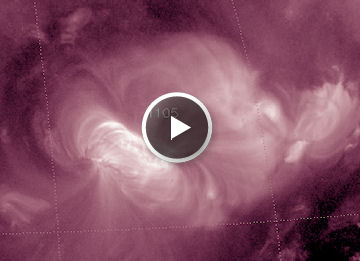
Watch it again. The
bubble is the dark crescent-shaped void expanding to the upper left of
the sunspot's bright magnetic canopy. Several copies of our entire
planet Earth could fit inside that volume with room to spare. What seems
huge by Earth-standards, however, is miniscule on the sun. At maximum,
the bubble occupied a volume less than 0.003% of the total solar globe.
It's all relative,
after all.
Stay tuned for bigger bubbles as sunspot
1105 continues
Current conditions
Solar wind
speed: 397.2 km/sec
density: 0.1 protons/cm3
explanation |
more data
Updated: Today at 2246 UT
X-ray Solar Flares
6-hr max: B1 2205 UT
Sep03
24-hr: B2
1520 UT Sep03
explanation
| more data
Updated: Today at: 2240 UT
|
9-2-10 sunspot 1101 and 1102
1100 continues its blast on the far side of the sun.
FARSIDE ACTIVITY CONTINUES: For the second day
in a row, NASA's STEREO-A spacecraft has detected a strong solar flare
on the far side of the sun.
Click here to view the flash of extreme UV radiation, which peaked
at 21:55 UT on Sept. 1st. The blast also hurled a coronal mass ejection
(CME) over the sun's southwestern limb:
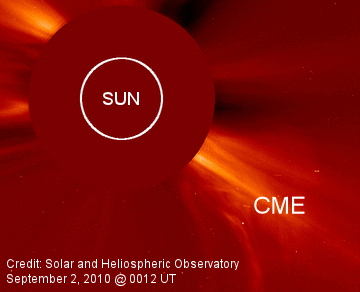
See the cloud expand:
0.6 MB gif animation
The cloud is heading in the general direction of Saturn
and poses no threat to Earth. Like the
similar flare reported yesterday, today's event was centered on old
sunspot group 1100. Solar rotation will turn this active region back
toward Earth for possible geoeffective action in about 7 to 9 days. Stay
tuned!
Current conditions
Solar wind
speed: 430.2 km/sec
density: 0.5 protons/cm3
explanation |
more data
Updated: Today at 2344 UT
X-ray Solar Flares
6-hr max: A7 2215 UT Sep02
24-hr: A7 0955 UT Sep02
explanation
| more data
Updated: Today at: 2340 UT
|
9-1-10 sunspot 1101 and 1102
Apparebtkt sunspot 1100 flared up on the backside of the sun, which will
not affect us on earth.
Current conditions
Solar wind
speed: 351.8 km/sec
density: 0.5 protons/cm3
explanation |
more data
Updated: Today at 2345 UT
X-ray Solar Flares
6-hr max: A9
2130 UT Sep01
24-hr: B1
0005 UT Sep01
explanation
| more data
Updated: Today at: 2340 UT
SPACE DATABASE ON THIS SITE
DREAMS OF THE GREAT
EARTHCHANGES - MAIN INDEX
|


















